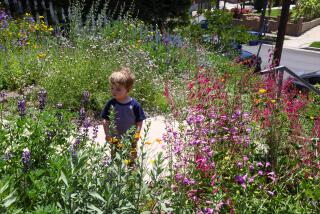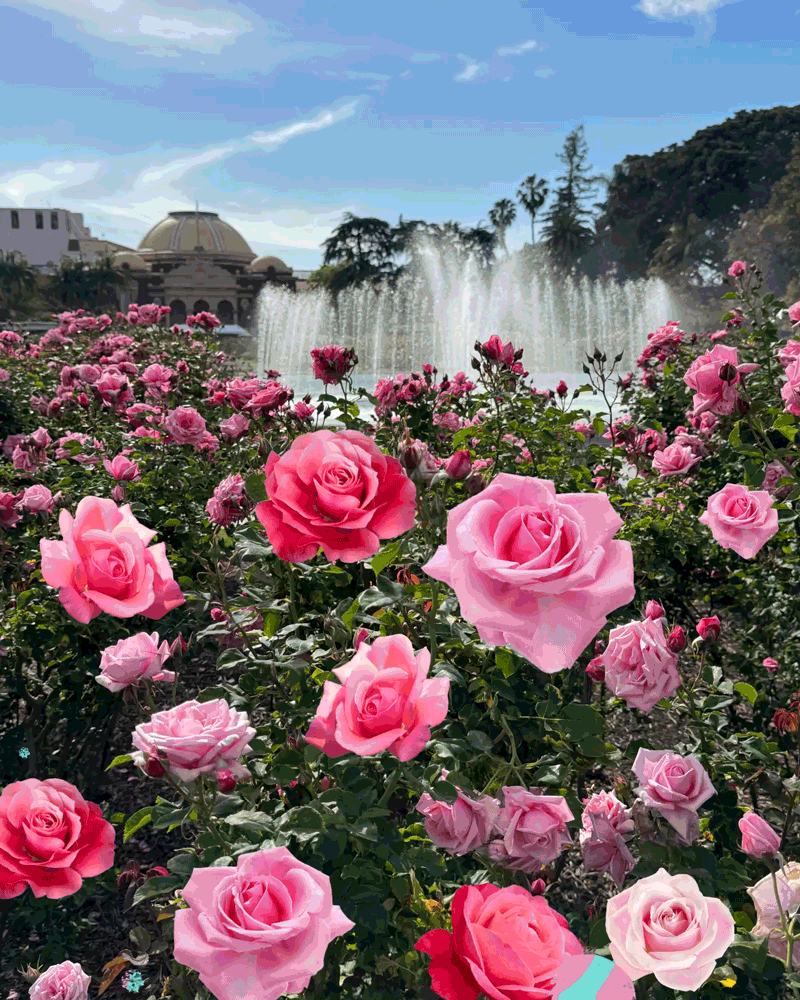Out of Africa and Into Color
- Share via
Gardeners are gradually learning that water-thrifty, drought-tolerant plants don’t have to look like dusty brown weeds.
The new South African Perennial Garden at the UCI Arboretum in Irvine illustrates how careful selection of these types of plants can result in easily maintained landscapes with colorful flowers and visual interest much of the year.
Visitors can easily stroll through the garden, consisting of mounded beds and well-maintained walkways around the perimeter and through the center. Decorative boulders are strategically placed near pathway curves and corners and at tree bases. Each plant is labeled with botanical name and place of origin.
The garden, designed and installed in spring 1994 by Brad Carter, assistant director of the arboretum, is now a brilliant showplace for South African plants, for which the arboretum is famous.
Because the soil is heavy clay, Carter decided to avoid the expense and labor of soil amending. Truckloads of sandy soil were brought in to create planting beds mounded 2 feet high and divided by the curving pathways.
Several hundred plants, from low-growing ground covers just a few inches tall to medium-sized trees and shrubs, fill a border that’s 250 feet long and 15 feet deep. Most are herbaceous perennials forming clumps of colorful foliage and flowers. Some produce attractive flower spikes of 5 or 6 feet. The garden is in full bloom spring through fall.
Many of the plants may look strange, but some, such as varieties of pelargoniums, species geraniums and scabiosa, may look familiar because they’ve gradually been introduced into the commercial landscape trade.
“We wanted to show people how well South African perennials, especially those from our conservation collection, can be used in home landscapes,” Carter said. “Many originate in climates similar to ours, so [they] are drought-tolerant and save the homeowner time and money.”
The perennial garden serves another practical function. It forms the background for the arboretum’s annual perennial plant sale, this year on May 11 from 10 a.m. to 3 p.m.
Gardeners can browse through the perennial garden, then purchase selections in pot sizes from 4 inches to 2 gallons, from $5 to $15.
Trailing or mounding ground covers--including Geranium incanum, Geranium robustum, Arctotis stoechadifolia ‘Burgundy,’ Plectranthus neochilus and Pelargonium peltatum ‘Claremont’--spill over in masses of purple, light blue, burgundy, mauve and pink.
Two- to 3-foot-tall plants are used in the center of the border. One that’s especially noteworthy is Scabiosa africana, a shrubby evergreen perennial that produces masses of flowers March through June. The plant, commonly called pincushion flower, will freely reseed throughout the garden and can be transplanted to desired sites or shared with friends.
Many varieties of Pelargoniums are also planted in the garden’s center. Look for the striking rose-pink flowers and heart-shaped leaves of P. cordifolium and the vigorous 6-foot-wide clumps of P. cuculatum, which bear masses of purple-pink flowers from March to fall.
Many of these plants attract hummingbirds, which feed from the small, tubular flowers of various watsonia species, near the back of the border. They also enjoy the pendulous pink or white flowers born on arching stalks of Diorama, also known as fishing rod plant.
“This is one of the most charming and beautiful of all the South African perennials,” Carter said. “Its delicate form is enhanced next to water or a pathway. It doesn’t like to be moved or divided. It’s native to grasslands, so [it] appreciates mulch around its roots.”
Although many South African perennials produce flowers in hues of pinks, red or stark white, some novel colors are also available.
One of the most unusual is the robin’s egg blue color of Whalenbergia rivularis, which bears clouds of these striking flowers that resemble campanula. Two-foot-tall flower spikes are profuse for about six weeks in March and April. The plant grows to a 2-foot mass.
Attractive, salmon-colored flowers are the featured attraction of Pelargonium ‘Irvine,’ a hybrid created at the UCI Arboretum. The foliage turns cranberry red in winter.
Carter has employed some effective landscape techniques in creating this garden. Gray foliage plants serve as transitions between plants that provide long periods of bloom but could have clashing colors.
“Gray softens the transition and also provides color throughout the year, even when flowers are absent,” he said.
Another technique is the placement of two or more groupings of a particular plant in different parts of the border, leading a viewer’s eye through the garden.
The garden is easily maintained, in part because a 4-inch layer of wood chips serves as mulch, reducing weed growth and retaining water. The garden exists on natural rainfall in winter and early spring and is deeply watered every 10 days during dry summer months.
It’s lightly fertilized in spring and summer.
Most of the plants are cut back in summer or fall, after blooming. Cuttings are used to propagate more plants for the sale. Many of these plants are easily grown from cuttings, so home gardeners can share with friends.
Although Carter encourages people to support the arboretum’s plant sale, he’s also trying to promote the plants’ use.
The new perennial garden, near the central lawn and gazebo, is a decorative site popular for weddings and other events. It also serves as a test garden where Carter can evaluate the practical landscape use for plant seeds and cuttings collected during his field trips to South Africa.
The UCI Arboretum is on the North Campus, near the intersection of Jamboree Road and Campus Drive. It’s open Monday through Saturday, 9 a.m. to 3 p.m. Call (714) 824-5833.
The annual perennial plant sale is May 11 from 10 a.m. to 3 p.m. Admission to the sale is $1 (free and early admission for Friends of the UCI Arboretum).






